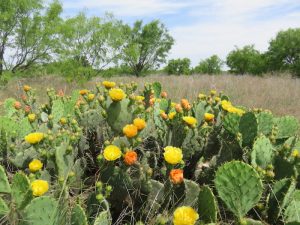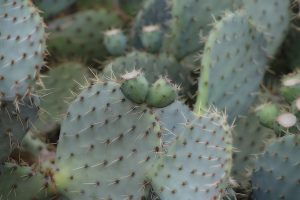As any experienced rancher knows, rangeland requires regular maintenance, especially when it comes to controlling invasive species, such as Opuntia engelmannii var. lindheimeri, more commonly known as the Texas pricklypear. The cactus, native to the American Southwest, can be a particularly, uh, thorny problem. During drought, pricklypear grows when nothing else will and can quickly overtake an entire pasture. If you’re finding massive stands of pricklypear where once tall grasses waved, it’s time to get serious and call in the experts.
 Free advice
Free advice
Unless you’re an experienced land manager and you know what you have to do, it’s best to start with a phone call to the local USDA office. The U.S. Department of Agriculture’s National Resources Conservation Service provides advice and assistance to landowners to restore wetlands, recover losses after wildfires, and control invasive species. Federal grants to assist with the cost of brush removal and land restoration are available through the NCRS Environmental Quality Incentive Program. Each state has its own NCRS website with extensive information about available assistance, programs, and local conditions and NCRS agents can help on a one-on-one basis.
Through its Brush Busters program, the Texas A&M University AgriLife Extension Service also provides do-it-yourself instructions for pricklypear removal on its website.
Proven methods of Pricklypear Removal
There are two generally recommended ways to get rid of pricklypear: spraying or mechanical removal with a grubbing hoe (isolated plants) or a skid-loader (large stands). Occasionally, controlled burns can be used, but burning requires lots of ancillary dry brush (cactus don’t burn easily) and fire isn’t selective. Burn bans in place throughout much of the Southwestern U.S. also take this method off the table for most.
Spraying and grubbing have distinct advantages and disadvantages, depending upon the size of the cactus growth and surrounding vegetation. Temperature and rainfall also can impact the success of your method. And cost can be an important consideration.
 1. Grubbing or the top-removal method
1. Grubbing or the top-removal method
Digging up cactus with a skid-loader is generally considered the most effective, immediate, and ecologically friendly way to remove large stands of pricklypear. It can, however, be costly, with rates for the equipment and operator reaching $80 to $100 an hour. Michael Dalrymple, a Mills County, Texas, contractor who specializes in brush removal, recommends a skid-loader equipped with a rock rake for attacking large stands of cactus. The tines of the rock rake permit dirt to fall back to the ground, thus reducing top soil loss and disposal weight. This process permits the operator to remove several inches of the root, enough to kill the plant.
Dalrymple recommends trenching a pit and burying the uprooted cactus under 18″ to 24″ of dirt. (Unlike cedar which can be piled and burned, piled cactus will re-root and grow into an impenetrable mound.)
It’s also important to collect as many of the fallen pads as possible. Each pad left on the ground has the potential to root and form a new cactus.
While mechanical removal can be done all year, fall and early winter are optimum to permit reseeding in time for the growing season.
2. Herbicides
Spraying works best on individual plants and thin growths of pricklypear. Because pads and stems must to be thoroughly coated, it’s virtually impossible eradicate a large, dense stand with ground-level spraying. It’s also important to avoid spraying near trees and mature vegetation, as their roots can take up the poison.
Aerial spraying is occasionally recommended for large stands of cactus at a safe distance from trees and other desirable vegetation, which could be damaged or killed by the herbicide drift.
While cactus can be sprayed year-round, most recommend using herbicides in warm weather when rainfall is expected, as moisture facilitates the uptake of the poison.
It can take six to eight months to see results and more than one application is often required to kill the cactus.
The Dow AgroSciences division of Dow Chemicals makes several effective herbicides, though two of the most well-known, Tordon 22K® and Surmount®, are federally restricted and require a license for use. Some ranchers recommend Dow’s PastureGard® HL herbicide for spot maintenance, as it can be used without a license. The cost to hire a licensed applicator varies locally but can run upwards from $35 an hour plus the cost of the herbicide.
 Restoration after Pricklypear Removal
Restoration after Pricklypear Removal
Once the cactus is gone, it’s important to reseed and restore the rangeland with a mix of native grasses, forbs (herbaceous flowering plants) and pollinators. Shop seed prices, as some native species can be very expensive.
Follow up, Follow up, Follow up
Invasive species management is never one and done. Spot spraying is the easiest way to remove isolated growths. Cactus growing near trees should be removed with a grubbing hoe to avoid damaging or killing the tree with heavy machinery or herbicides. It doesn’t take long for little cactus plants to become a big nuisance. However, with regular maintenance, your eradication efforts will pay dividends for years to come.
Download Printable eBook for this Article
Helpful Resources for Pricklypear Removal
Texas A&M University AgriLife Research and Extension Service
National Resources Conservation Service
Texas A&M AgriLife Brush Busters Program
Author: Blake Hortenstine


 1. Grubbing or the top-removal method
1. Grubbing or the top-removal method Restoration after Pricklypear Removal
Restoration after Pricklypear Removal